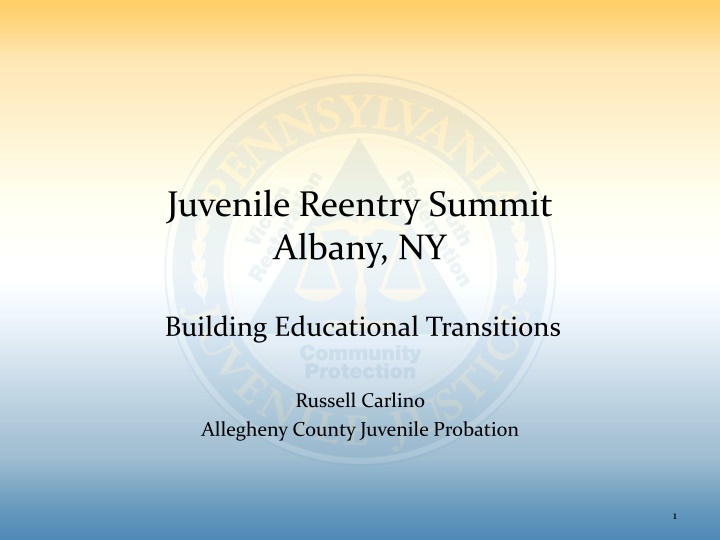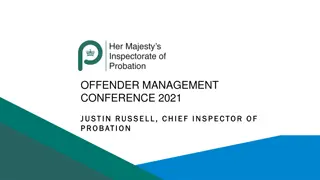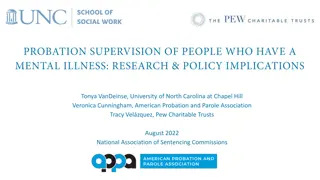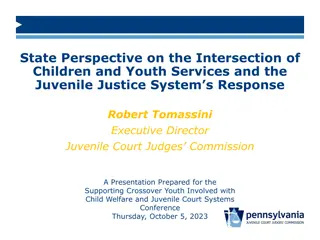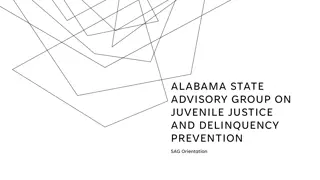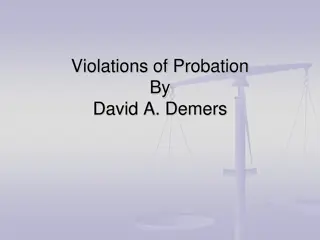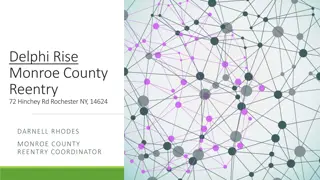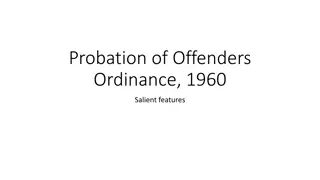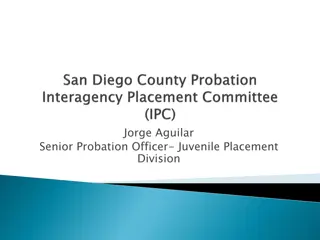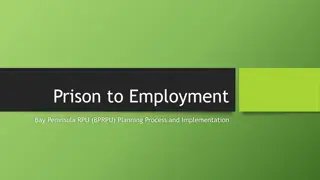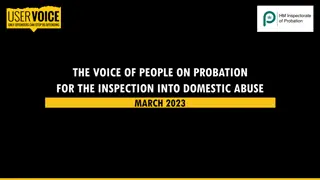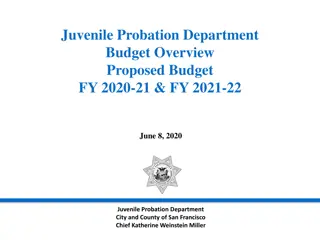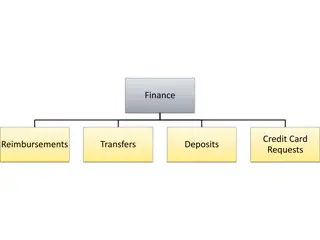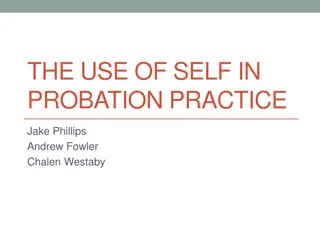Juvenile Reentry Summit in Albany, NY: Building Educational Transitions with Allegheny County Juvenile Probation
Explore the Juvenile Reentry Summit in Albany, NY, focusing on building educational transitions with insights from Russell Carlino of Allegheny County Juvenile Probation. Discover the demographics of Allegheny County, its decentralized PA system, and the Allegheny County Court of Common Pleas Family Division Juvenile Section. Learn about good juvenile probation practices, balanced and restorative justice principles, and the importance of community protection and offender accountability.
Download Presentation

Please find below an Image/Link to download the presentation.
The content on the website is provided AS IS for your information and personal use only. It may not be sold, licensed, or shared on other websites without obtaining consent from the author.If you encounter any issues during the download, it is possible that the publisher has removed the file from their server.
You are allowed to download the files provided on this website for personal or commercial use, subject to the condition that they are used lawfully. All files are the property of their respective owners.
The content on the website is provided AS IS for your information and personal use only. It may not be sold, licensed, or shared on other websites without obtaining consent from the author.
E N D
Presentation Transcript
Juvenile Reentry Summit Albany, NY Building Educational Transitions Russell Carlino Allegheny County Juvenile Probation 1
Allegheny County Allegheny County Demographics Demographics US Census 2010 US Census 2010 Population -1.22 Million 730 Square Miles 130 Municipalities Including Pittsburgh 43 School Districts Population Age 10 - 19 148,330 Over 140 Police Departments 2
5th Judicial District of PA PA System Decentralized 67 Counties Probation is under Judicial Branch Juvenile Court Judges Commission advisory body, establish standards Probation handles case from opening to closing Allegheny County Among the 25 largest court systems in the nation 43 Common Pleas Court Judges 46 Managerial Districts More than 1,200 employees 3
Allegheny County Court of Common Pleas Family Division Juvenile Section Juvenile Court Judges - 15 Juveniles active with Court - 3,100 Delinquency referrals received in 2011 4,800 Average in private placement on a given day in 2011 - 282 Restitution/Fines/fees Collected in 2011 - $391,166 Recidivism while under supervision in 2011 13.5% 4
Good Juvenile Probation Practice Mission Driven Performance-Based Outcome-Focused 5
Balanced and Restorative Justice Our mission becomes PA law in 1996 Changes to the Juvenile Act s Purpose Clause (1995) mandates balanced attention to 3 goals: Community Protection Offender Accountability Competency Development 6
Community Protection The process of contributing to safe communities through prevention, supervision, and control. Identify the Risk Manage the Risk Minimize the Risk 7
Accountability Juvenile offenders must: Understand the harm they ve caused Understand the impact of the crime Take responsibility for the crime Restore victims and communities 8
Competency Development is The process by which juvenile offenders acquire the knowledge and skills they need to become community members who are: productive connected law abiding 5 Domains 1. Pro social 2. Moral Reasoning 3. Academic 4. Workforce Development 5. Independent Living 9
Probation Department Units (Decentralized in 1974) Intake Department Community Based Probation (7 Superv. Units) D&A Unit Sex Offender Unit YLS Unit Warrant Unit School Based Probation (6 Superv Units) Educational Specialist Community Intensive Supervision Program (CISP 6 Centers) 10
School-Based Probation est. 1994 Began with 3 POs in Pittsburgh Schools Partnership with school- improved communication Supervise all court active juveniles in school On-site intake (divert whenever posssible) Not a pipeline to juvenile court School-based but court supervised Currently: 38 SBPOs 20 POs in Pittsburgh Schools 18 POs in suburban school districts 20 of 43 school districts have SBPO 11
Community Intensive Supervision Program (CISP) est. 1990 Court Operated Program Step-up from Probation supervision Alternative to residential placement Aftercare (step-down) for juveniles released from placement since 1997 6 Centers in Pittsburgh area 12
CISP Programming Day/Evening program with 24/7 supervision Electronic monitoring/random drug testing Daily school attendance Employment opportunities Evidence-based programming Progressive sanctions for program/ technical violations Parent Support Groups Collaboration with community agencies 13
Aftercare Offenders are most likely to re-offend during the first several weeks after release from placement Goals of aftercare (re-entry): 1. To protect the community during this high-risk post release period 2.To assist the transition to the home, community, and school 14
Allegheny County Juvenile Probation Aftercare Policy Implemented in 1997 Aftercare planning begins with the recommendation for placement PO participates in initial case planning conference in person or via video/teleconference Monthly visits to in-county and out-of-county placements Juveniles exiting residential placement are transitioned to aftercare at CISP or other Day/Eve Program Has reduced average length of stay 15
Aftercare Becomes Statewide Initiative in 2005 Pennsylvania Joint Statement on Aftercare January 17 Goal Statements Provide vision for Aftercare Stakeholders Involved Dept. of Public Welfare Dept. of Education PA Commission on Crime and Delinquency Juvenile Court Judges Commission PA Council of Chief Probation Officers 16
Joint Statement on Aftercare contd Combination of services, planning, support, and supervision Begins at disposition and continues throughout placement Probation and facility staff will establish a single plan within 30 days of placement that includes education goals Anticipates and plans for release Continues through the case closing and connects youth to support and services in the community 17
Joint Statement on Aftercare contd Competency development is a key focus of placement and aftercare Competency development must include academics and career and technical training Progress in placement must be coupled with seamless continuation upon re-entry 18
Allegheny Countys Education Specialists Three year grant beginning in 2005 now budgeted positions Three full-time non probation officer positions Broad system focus on all aspects of education from records to performance to reintegration Work with residential staff, POs , 43 school districts, local Intermediate Unit Coordinate reintegration to home school Individual attention to specific cases (over 300 in placement) Supplement not supplant PO s responsibilities 19
Allegheny and Philadelphia Join Forces (2008) PACTT (Pennsylvania Academic & Career and Technical Training) Allegheny and Philadelphia Probation join to improve academic and employment outcomes for PA juveniles in delinquent facilities Sponsored by PA Council of Chief Juvenile Probation Officers Funded by MacArthur Foundation, PCCD and Stoneleigh Center Projected to last five years Not a program but a way of doing business Raise expectations/performance 20
PACTT PACTT evolves from PA efforts to improve Aftercare Key Stakeholders Support : Juvenile Justice Providers Department of Education PA Commission on Crime and Delinquency Juvenile Court Judges Commission Workforce Investment Boards Department of Public Welfare (provider oversight) 21
PACTT Structure 4 full-time PACTT positions Director, Asst. Director, Academic and CTE Specialists 9 pilot providers (accounted for approximately 65% of all PA placements) Focus on Philadelphia and Pittsburgh School Districts Cross-system advisory board Technical assistance from specialists 22
Competency Development Academic and Workforce Development Important regardless of risk level/system penetration PACTT Focus Credit Recovery and Academic Advancement Career and Technical Training For those entering or exiting placement Key BARJ Component leading to productive citizenship 23
PACTT Challenges Pennsylvania s decentralized JJ structure Over 150 private facilities with individual county contracts 67 counties 501 school districts Probation: Historically inconsistent expectations Inadequate input/monitoring 24
PACTT Challenges Statewide Issues significantly behind in grade level Record transfers Rolling admissions/ discharges Poor communication between home/host school Home school resistance to re-entry (alternative ed.) Lack of clear guidelines and expectations from probation 25
What PACTT Provides On-site assistance and trainig to providers, probation depts Assistance developing CTE programming Professional development for provider teachers (literacy) Communication with school district administrators and workforce investment board staff Support from PA Juvenile Probation Chief s Assoc. Feedback on outcomes to providers and probation depts 26
PACTT Academic Goals Improve records transfer Align curricula with state standards and local graduation requirements Focus on credit recovery/acceleration: credits based on competencies, not seat time Use software programs to provide individualized remediation, recovery, and acceleration (eg. Nova Net, Plato) Expand school day, school year Integrate academics and CTE training 27
PACTT CTE Goals Assess CTE programs in placement Introduce standardized soft skills training Focus on high demand, high employability occupations Ensure CTE training based on industry standards and competencies, lead toward recognized certification Use standard documentation of competencies to ensure portability Develop opportunities for subsidized work in placement and community 28
PACTT CTE Goals Basic Certifications: Soft skills training OSHA-10 ServSafe Microsoft Office Driver s permit/license CTE Programming: Auto mechanics Auto body Culinary Optics Bldg maintenance Office technology 29
PACTT Accomplishments OHSA 10 Occupational Safety and Health Administration Two 10 hour certifications General Industry Construction Provides employers with entry level employees trained in basic safety Resume/portfolio enhancer 30
PACTT Accomplishments ServSafe ServSafe Developed by National Restaurant Assoc. Safe food handling ServSafe is an approved program in PA Resume/portfolio enhancer - attractive to employers Competency Development Skill 31
PACTT Accomplishments Microsoft Office Specialist Skills learned will enhance the overall educational experience Word Processing Spreadsheets Presentations Initial instruction may be infused within other instructional programs such as language arts or math 32
PACTT Accomplishments Employability/Soft Skills Manual Provides guidance for work-ready training Identifies 27 competencies 5 general domains 1. Post secondary education 2. Job seeking skills 3. Job keeping skills 4. Life skills 5. Personal and social development skills Represent minimum set of skills needed to prepare for successful employment 33
PACTT Accomplishments Driver s Permit/Education Transportation is an issue when securing employment Official identification Basic competency development skill 34
PACTT Accomplishments The Portfolio Employability competencies Career Plan Resume Sample Applications Education and career/technical Copies of certifications Copy of transcript(s) Awards, certifications 35
PACTT Affiliation Affiliation residential and day treatment providers who meet academic and CTE standards established by PACTT Signed agreement Reviewed and renewed annually Affiliation Requirements: Align academic curriculum to PA standards Offer remediation, credit recovery, and acceleration Obtain school records within 10 days of admission; return records within 5 days of release Offer Employability/Soft Curricula for over 14 36
PACTT Affiliation contd Provide opportunity for certification (OSHA-10, ServSafe, etc.) One or more CTE tracks aligned with industry standard, including 90 hours of skill training Develop portfolio Establish relationship with local Workforce Invest. Bd. Provide data to PACTT As of October 2012, 25 residential facilities (state and private) and two day-treatment programs have affiliated 37
PACTT/Aftercare Aligning with aftercare programs in Philly and Pittsburgh (CISP Centers) Develop community-based internships and job opportunities for youth returning from placement Work with school districts to expand the academic options available to youth upon their return to the community Work with local Workforce Investment Boards 38
Providing youth with work experience LEARN TO EARN GRANT PA Department of Labor and Industry Partnership with local Goodwill Targeted 112 youth exiting two residential placement facilities Focused on Indoor/Outdoor Maintenance, Landscaping and Culinary Arts Paid work experiences at the facility and in the community Learning experience for Prob Dept as well 39
PACTT Outcomes In 2011, over 1500 Allegheny and Philly youth discharged from PACTT affiliated facilities Over 20% earned a high school diploma or GED in placement (25% the first half of 2012) 50% completed the Soft Skills Employability curriculum 33% earned a basic certification (ServSafe, OSHA 10, etc.) 20% completed at least 50 hours paid work in area of training Through June of 2012, over 30% completed 90 hours of training in a CTE track (culinary arts, auto tech, carpentry, indoor/outdoor maintenance, or computer skills) 40
Probation Officers Role Aftercare planning begins with decision to place Consider academics/CTE when recommending placement Attend initial planning meeting Facilitate speedy record transfer both ways Facilitate home/host school communication Establish timeframes for completion during both placement and aftercare Review plan with juvenile, family, residential staff, school Highlight plan in review hearings 41
JJSES Framework Achieving our Balanced and Restorative Justice Mission 42
Criminogenic Needs Identified in Youth Level of Service (YLS) Top 4 + one Next 4 1. Attitudes/Orientation 2. Personality/Behavior 3. Peer Relations 4. Family Circumstances Prior/Current Offenses (static) 1. Substance Abuse 2. School/Education 3. Employment 4. Leisure 43
Risk/Needs Results Continuum of Services Least Restrictive Alternative Risk determines system penetration Structured Decision Making Fence Secure Intake CD Probation Day Group Home Non Secure resid. Treatment (CISP) Diversion Needs determine services within each level 44
Balanced and Restorative Justice Goals The protection of the community The imposition of accountability for offenses committed The development of competencies to enable children to become responsible and productive members of the community 46
Lessons Learned Mission drives practice Establish clear directives and supporting policies Build necessary infrastructure (e.g. CISP Centers) Use outside experts when necessary Build Momentum locally and statewide Include key stakeholders (providers, state agencies, etc.) Sustained effort - keep drilling until it becomes part of the routine 47
A BIG challenge: Reducing the age-crime curve Source: Loeber & Farrington, 2012 48
russell.carlino@alleghenycourt.us 412 350-0211 49
